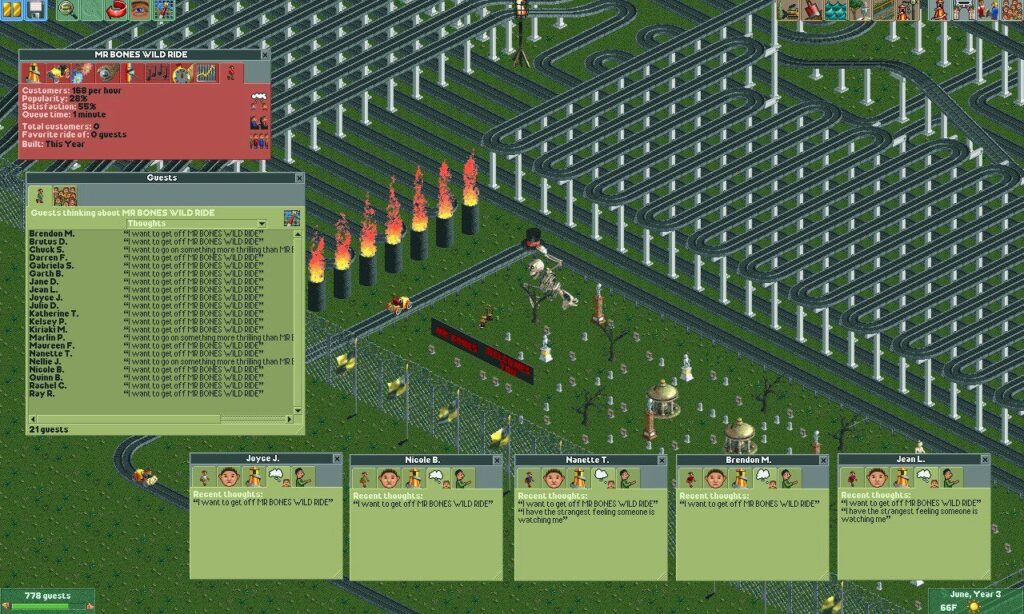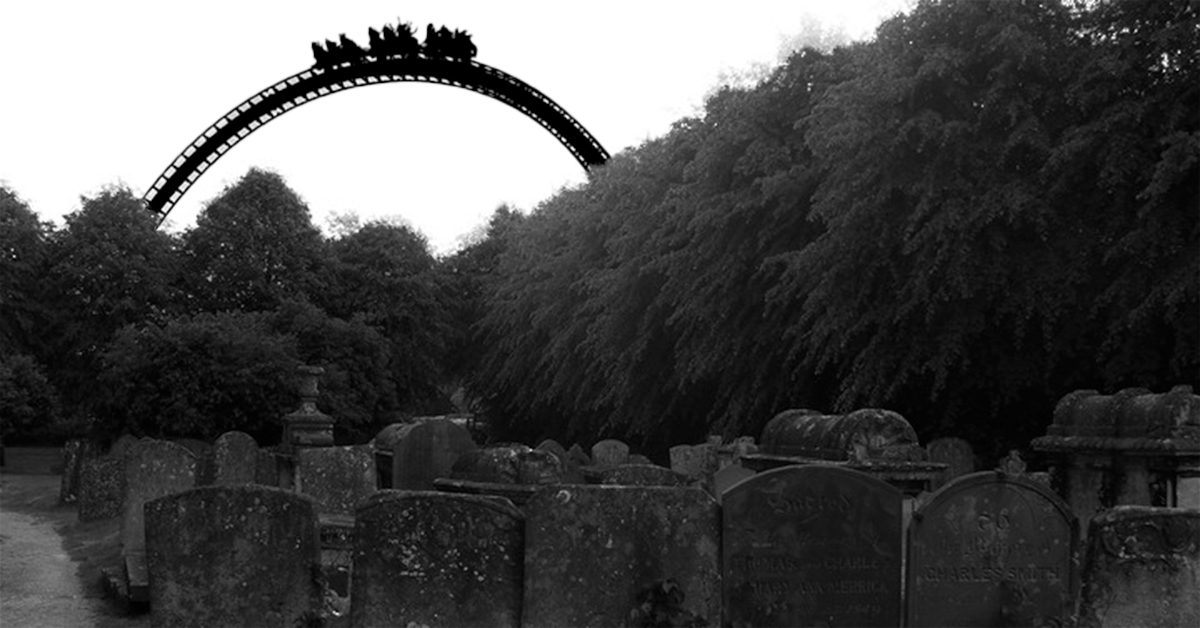Content Warning: Suicide and euthanasia
One of my favorite pieces of internet history is the brief story of Mr. Bones’ Wild Ride. First seen on 4chan in 2012, “Mr. Bones’ Wild Ride” is the name of a rollercoaster created in Rollercoaster Tycoon 2, a classic theme park building game/torture simulator. The ride’s convoluted and circuitous skeleton-themed track winds around most of the available map space and takes four years (in game) to complete from start to finish. When riders finally reach the end, they exit the coaster through a specially-marked door and enter a queue that takes them… straight back to the entrance. They have no choice but to get back on Mr. Bones’ Wild Ride. What starts as a fun diversion for the little simulated people becomes a nightmare as they enter a never-ending-loop of four-year rides. Using an in-game feature to peer inside the minds of each of the visitors, the poster points out that each one of them has only one thought, recurring over and over: “I want to get off Mr. Bones’ Wild Ride!”

Mr. Bones’ Wild Ride isn’t real, much to the disappointment of fans of shitty 2012 creepypasta. But the sentiment of dreadful recursion, the endless repetition of horrifying monotony, it strikes a chord with some folks. This is a euthanasia story.
Switching Tracks
Assisted suicide and euthanasia are still relatively controversial topics in the United States, where their legality varies from state to state. It’s worth noting that the difference between the two is that assisted suicide involves receiving aid, usually from a doctor, that allows a person to safely and humanely end their own life, while euthanasia puts the responsibility of death on the helper. In other words, assisted suicide is what it sounds like; euthanasia is nice murder.
The debate comes with a ton of baggage, much of it relying on religious or philosophical ideas related to the sanctity of life, but also some important points about informed consent (who gets to say “I want to die” and when?). This article won’t try to make a judgment. It’s cooler than that.
Among euthanasia enthusiasts, there’s something of a sprouting industry of machines designed to kill the operator. Think gun but without the mess and the hassle. In most cases, this effect is achieved either through intravenous chemical injection or the use of gas masks that supply the breather with lethal doses of carbon dioxide.
They come with cool 80s sci-fi names like “Thanatron”, “Mercitron”, and “Deliverance Machine”. Most that I’ve been able to find look like they haven’t been aesthetically updated since that decade. I guess prospective customers probably aren’t in it for the vibes. More recent designs include a 3D-printable computer-operated sarcophagus. It’s one way to deal with the emotional aftermath of shelling your savings on a really big printer.
A lot of the work in this area is conceptual, and the “industry” is tremendously limited in scope – you won’t find a suicide sarcophagus at Target. It’s also not likely to grow at an astounding rate, given that satisfied customers rarely return for a follow-up purchase. Regardless, to me, most of these devices are boring and overly-clinical. If we’re leaving this world by choice, why not have some fun with it? Artist Julijonas Urbonas had a similar question.
Officially, the Euthanasia Coaster is an art project. No one’s ever built one, and, as far as I know, there are no plans to build one in the near future. But if it were to be built, it’d be massive, taller than the Empire State Building at its highest and occupying an even greater amount of horizontal real estate. Riders would strap in and experience a slow initial climb to the top (plenty of time to rethink the whole dying thing) and then a rapid quarter-mile drop before entering the first of seven loop-de-loop inversions, each of which increases the G-force on the riders, making it harder and harder to breathe until they all die.
And then the ride ends, obviously. Anything more would be overkill.
It’s probably worth noting that, as designed, riding the Euthanasia Coaster wouldn’t be a painful experience. Urbonas describes a certain lightheaded euphoria going from the drop to the first inversion loop. Euthanastronauts would then black out before the second loop starts, so the actual dying would be going on behind the scenes.
The design is clearly metal as fuck, but the artist’s (alleged) intent was to offer up a more fulfilling way to end one’s life, one that could be augmented with the thoughts experienced as they painlessly feel death approaching. It could be spiritual, philosophical, whatever, but it’d be outside in the open air on an otherwise exhilarating ride versus the alternative of being attached to a computer running MS-DOS in a latex-scented medical office lit by fluorescent overhead lamps.
Urbonas also argues his image of death would include an in-built mourning component, as loved ones would be able to attend the deaths of their friends and family members and know that they went out screaming, but in a good way. I don’t know about that one, though. Watching grandma’s roller coaster ride to hell feels like an uncomfortable way to start a funeral.
The coaster also isn’t without its limitations. The whole “blackout and subsequent death” thing occurs because intense g-forces pull blood from your brain down to your lower extremities (legs, et al.), depriving the brain of oxygen. If you don’t have lower extremities, your results may vary. Fighter pilots are also trained to mitigate the effects of high g forces on the human body, so a sufficiently-talented and well-equipped pilot could also conceivably disembark safely at the end of the ride. Urbonas’s website quotes an Irish pilot who muses about doing just that. I wouldn’t recommend it, but I guess if you do fail, you’ll be in good company.
As we’ve established, there are no euthanasia coasters in operation. Beyond the obvious and boring ethical debate, barriers to construction include cost (millions of dollars on the low end) and size; being that the coaster is at least a half-mile tall and longer than that, it’d automatically become one of the largest and most apparent structures wherever it’s built. Imagine having the view out your office or apartment window dominated by Suicide Six Flags. Some of you creeps probably think that’d be neat, but NIMBY paladins have gone all out for much less.
But I suppose it’s not worth stoking debate on, because for all the effort he put into the project, Urbonas isn’t fighting tooth-and-nail for the construction of his coaster. It’s an art project, meant to look cool and get you thinking.
If nothing else, though, the Euthanasia Coaster has led to development in one key area: nine years ago, Mr. Bones spent years killing theme park visitors. Now, with the help of Julijonas Urbonas, players of Planet Coaster, a spiritual successor to the Roller Coaster Tycoon series, can do the job much more efficiently.
Read More
- Euthanasia Coaster (2010) by Julijonas Urbonas
- A Roller Coaster Designed to Kill People by Blake Butler for VICE
- Euthanasia Coaster by Antonio Damasio for the Design and Violence exhibit at the Museum of Modern Art
Title Image
- Graveyard in Black and White by Wikipedia user Klak of Klak, edited
- Licensed under the GNU Free Documentation License
- Rollercoaster silhouette by Pixabay user AhiruR
Images
- Euthanasia coaster profile by Wikipedia user RicHard-59
